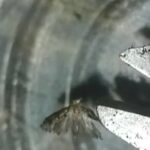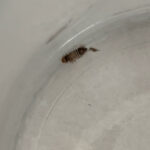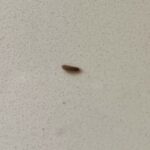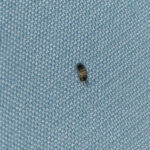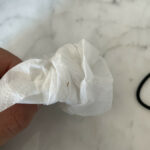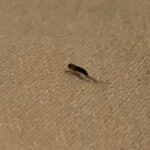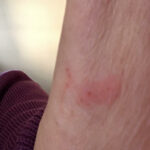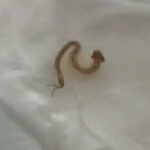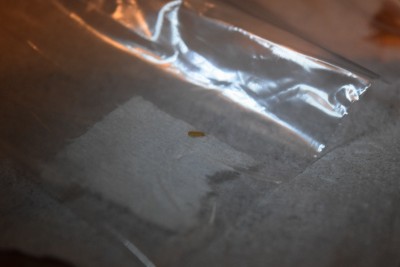
This is a case bearing clothes moth larva! These larvae are considered to be pests since their eating habits can cause a bit of damage to household items. They prefer to snack on animal products such as wools, feathers, felt, and leather, but they will also eat plant products. In other words, they might eat just about anything in your closet or on your bed. The larvae spin silk tubes that they live inside as they develop and mature. The outside of the tube collects dirt, sand, and other small particles while the inside remains silky and safe for the larvae. They drag this case around during their entire developmental larval stage, and they attach it to a wall when they are ready to pupate. We will go over tips for getting rid of these larvae in just a bit, but first, let’s take a look at the other creature:
Although the specimen in this photo is pretty small, we recognize it right away…this is a carpet beetle larva. Carpet beetle larvae have nearly identical eating habits as case bearing clothes moth larvae, so it makes sense that they were discovered in the same place. While neither of these household pests is actually dangerous or harmful, both can cause a lot of unwanted damage to household goods, so it is important that our reader get to work immediately in order to stop an infestation from occurring.
The first thing she needs to do is search for the primary food source for these larvae. We think it is probably an item of her bedding set or her mattress since that is where she noticed the specimens. It could also potentially be something in the linen closet from which she got the sheets that she put on the bed. Anything she finds that shows signs of damage needs to be removed immediately and either thrown out, laundered or professionally cleaned since it might be full of additional larvae or eggs. After all infested items have been taken care of, our reader will need to stick to a daily cleaning regime to eliminate all other eggs, larvae, and future potential food sources. This should include doing laundry, vacuuming, sweeping, and dusting. Although the daily cleaning might seem excessive, we promise it is worth it in order to not have a full-blown infestation on her hands!
To wrap up, one of our readers discovered two specimens on her bed: case bearing clothes moth larvae and carpet beetle larvae. Both of these larvae are considered to be household pests, so it is important that our reader begin cleaning to get rid of them ASAP to keep the damage to a minimum.
All About Worms is always free, always reader-supported. Your tips via CashApp, Venmo, or Paypal are appreciated! Receipts will come from ISIPP Publishing.
You might also find these guys interesting!






